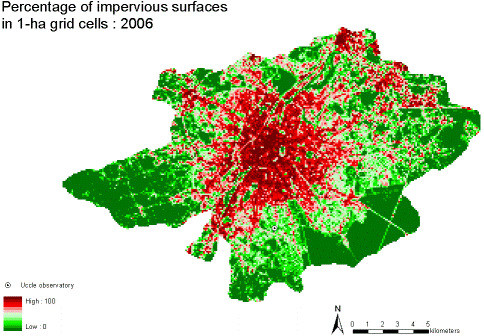Estimating Urban Heat Island Effects on the Temperature Series of Uccle (Brussels, Belgium) Using Remote Sensing Data and a Land Surface Scheme
Abstract
:1. Introduction
2. Data and Model
2.1. Study Area
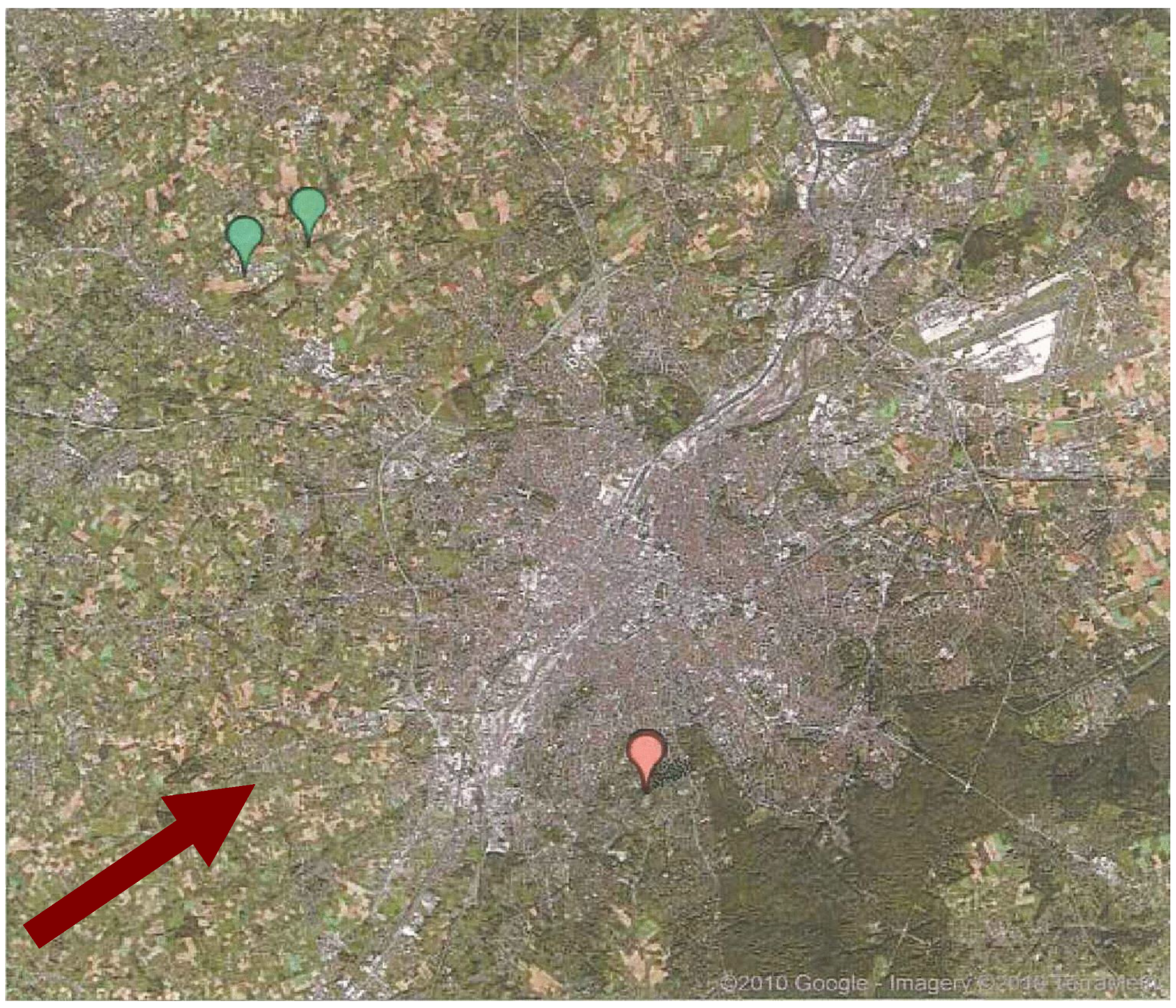
2.2. Meteorological Weather Station
| Time span | Observation time | Location (above mean sea level) |
|---|---|---|
| 1 June 1955–31 August 2006 | Daily max- and minimum | Uccle (104 m) |
| 1 June 1991–31 August 2006 | Daily max- and minimum | Brussegem ( ~53 m) |
| 1 June 1980–31 August 1990 | Daily max- and minimum | Asse (~53 m) |
| 1 June 1955–31 August 1971 | Daily max- and minimum | Asse (~53 m) |
2.3. Evolution of Surface Cover Fraction
- (i)
- From 1950s to 1980s: Vanhuysse et al. [12] used the MURBANDY database [3] available for 1955, 1970, and 1985 and then estimated the fraction of impervious surfaces using topographic maps and aerial photos. Initially, an interpretation of land use in 1997 was carried out visually on the screen, based on satellite images IRS/1C (spatial resolution 5.8 m), and aerial orthophotos (5 m spatial resolution). The legend of reference is derived from CORINE Land Cover but has a higher degree of detail for artificial surfaces. The minimum mapped area is 1 ha for artificial surfaces and 3 ha for other surfaces. Then, for 1955, 1970 and 1985, the database of 1997 was retrospectively updated using information from maps and aerial photos of the period. For each of the three dates, topographic maps at 1:5,000 were scanned, georeferenced, and overlayed with the MURBANDY/MOLAND data. The interpretation was carried out visually using a geographic information system (ArcGIS v9.1). For 1985, the coverage map at 1:5,000 was not comprehensive enough and had to be supplemented by aerial photographs. The final results indicate that the percentage of impervious surfaces has increased from 26% in 1955 to 39% in 1985.
- (ii)
- From 1980s to 2006: Vanhuysse et al. [12], first, conducted a binary classification of land use on the basis of a very-high-resolution satellite image (UrbOrtho, QuickBird) dating from 2006 (see Table 2). They used the software eCognition Professional v4.0, which allows a classification by region (object-oriented classification) based on fuzzy logic. The regions are assigned a class according to their degree of belonging to this class, as determined by the nearest neighbor algorithm and/or membership functions modeled by the user. The final result was made binary keeping only two classes: pervious and impervious surfaces. A grid mesh of 30 meters per side was generated by referring to the Landsat images, so that, each mesh covers exactly one Landsat pixel. Thus, applying the binary classification on the grid, they were able to extract the percentage of impervious surfaces in each cell. Then, they built a simple regression model between the percentage of impervious surfaces and different spectral variables derived from high-resolution Landsat images: NDVI (Normalized Difference Vegetation Index), PVI (Perpendicular Vegetation Index), SAVI (Soil Adjusted Vegetation Index), MSAVI2 (Second Modified Soil Adjusted Vegetation Index), and BI (Brightness Index). This model permitted to estimate the percentage of impervious surfaces for two previous dates (1993 and 1986) for which only high-resolution images (Landsat Thematic Mapper with 30 m resolution) are available. The final results indicate that the percentage of impervious surfaces has increased from 39% in 1985 to 47% in 2006 (see Figure 2).
| Year | Image | Spatial resolution |
| 1986 | Landsat TM | 30 m (B, V, R, PIR, MIR), 120 m (TIR) |
| 1987 | Landsat TM | 30 m (B, V, R, PIR, MIR), 120 m (TIR) |
| 1993 | Landsat TM | 30 m (V, R, PIR, MIR), 120 m (TIR) |
| 2003 | Landsat ETM+ | 30 m (B, V, R, PIR, MIR), 60 m (TIR), 15 m (pan) |
| Year | Image | Spatial resolution |
| 2005 | Spot HRV | 20 m (V, R, PIR) |
| 2003 | Spot HRG | 2.5 m (pan-supermode) |
| 2006 | QuickBird | 2.4 m (B, V, R, PIR), 0.6 m (pan) |
| 2004 | UrbOrtho | 0.6 m (B, V, R) |
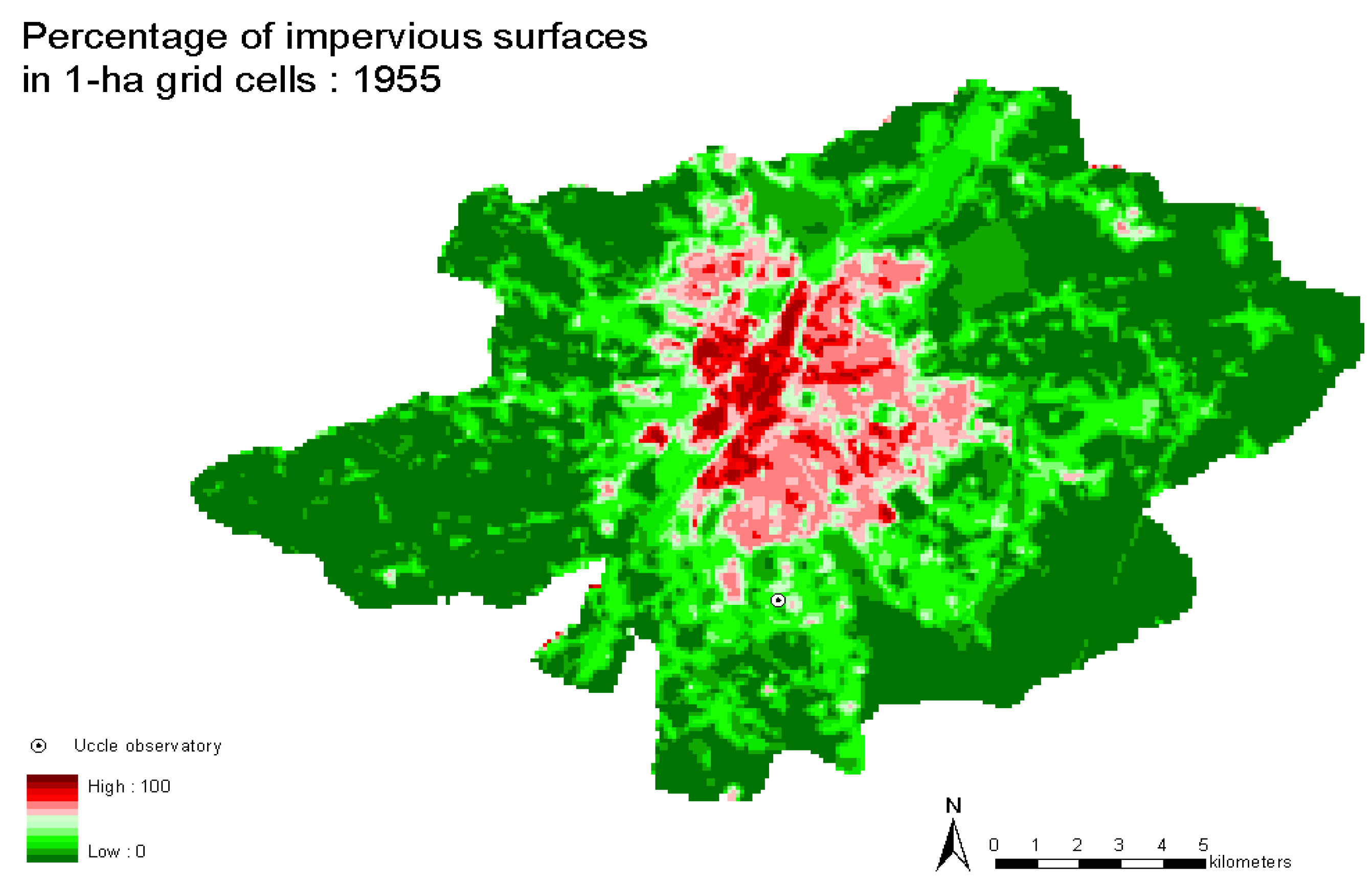
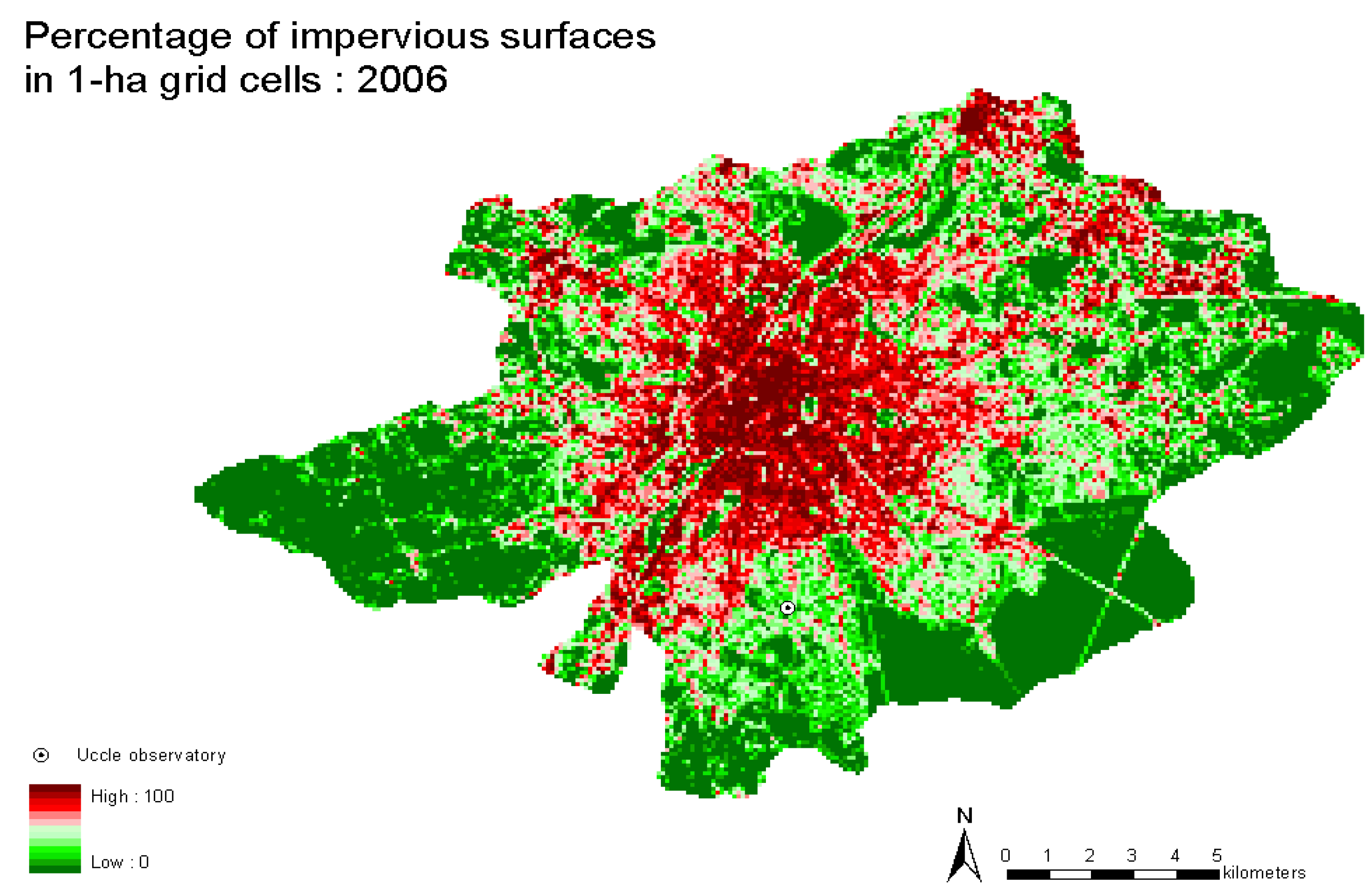
2.4. Atmospheric Data
2.5. Land Surface Scheme
2.6. Model Parameter
3. Results and Discussion
3.1. Urban Warming from Weather Stations
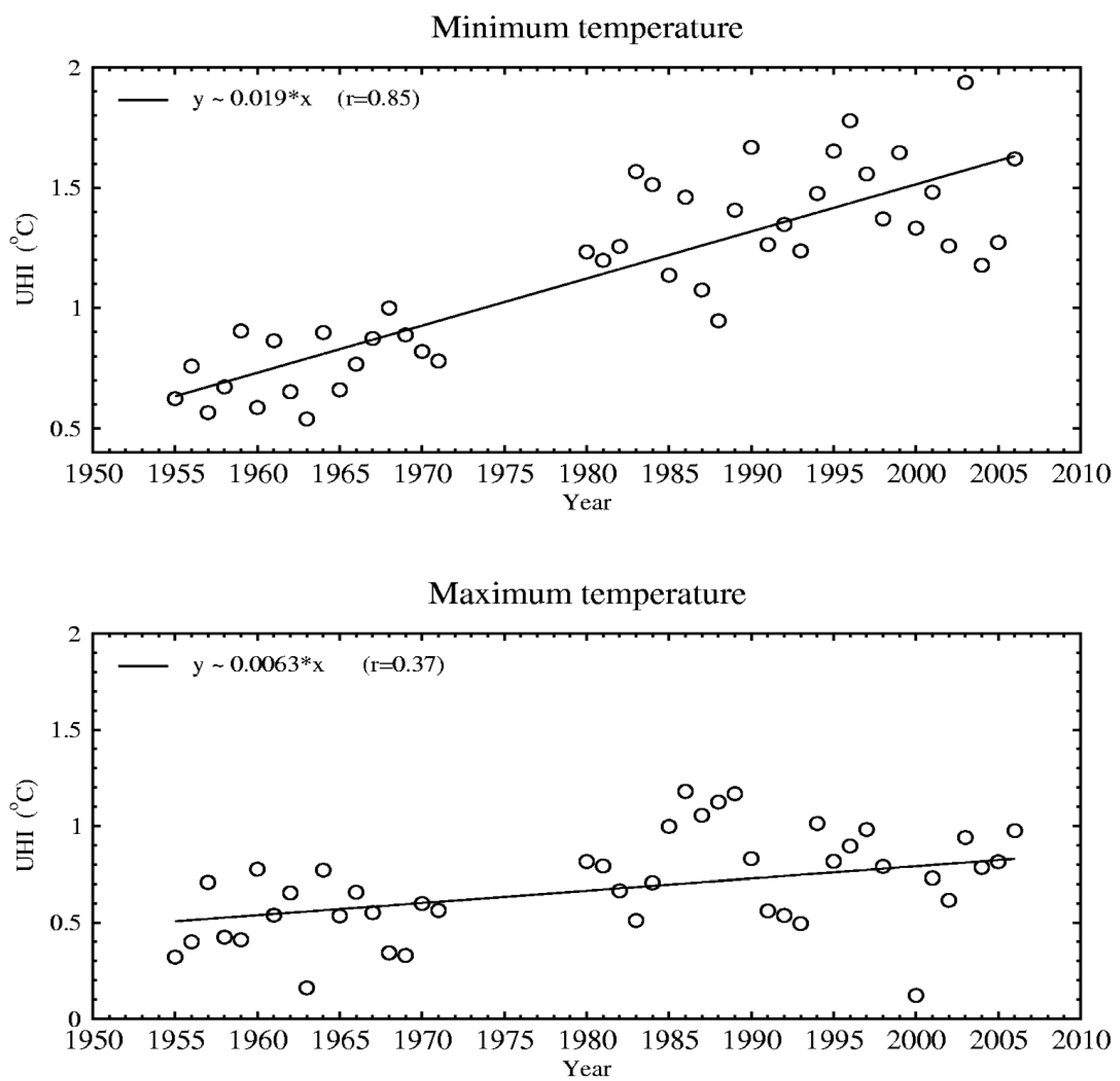
3.2. Urban Warming from Model Simulations
3.2.1. Evaluation of the Model
| Correlation | Index of agreement | Bias (°C) | RMSESYS (°C) | RMSEUNSYS (°C) | |
| TMAX | 0.96 | 0.97 | 1.12 | 1.38 | 2.33 |
| TMIN | 0.96 | 0.97 | -0.43 | 0.66 | 1.89 |
3.2.2. Urban Warming
- We consider BCR as a lumped urban volume.
- The entire BCR is composed of one homogeneous material comprising uniform thermophysical properties, irrespective of spatial variability.
- Urbanization was assessed only by measuring changes of the impervious surface area (percent) in the BCR.
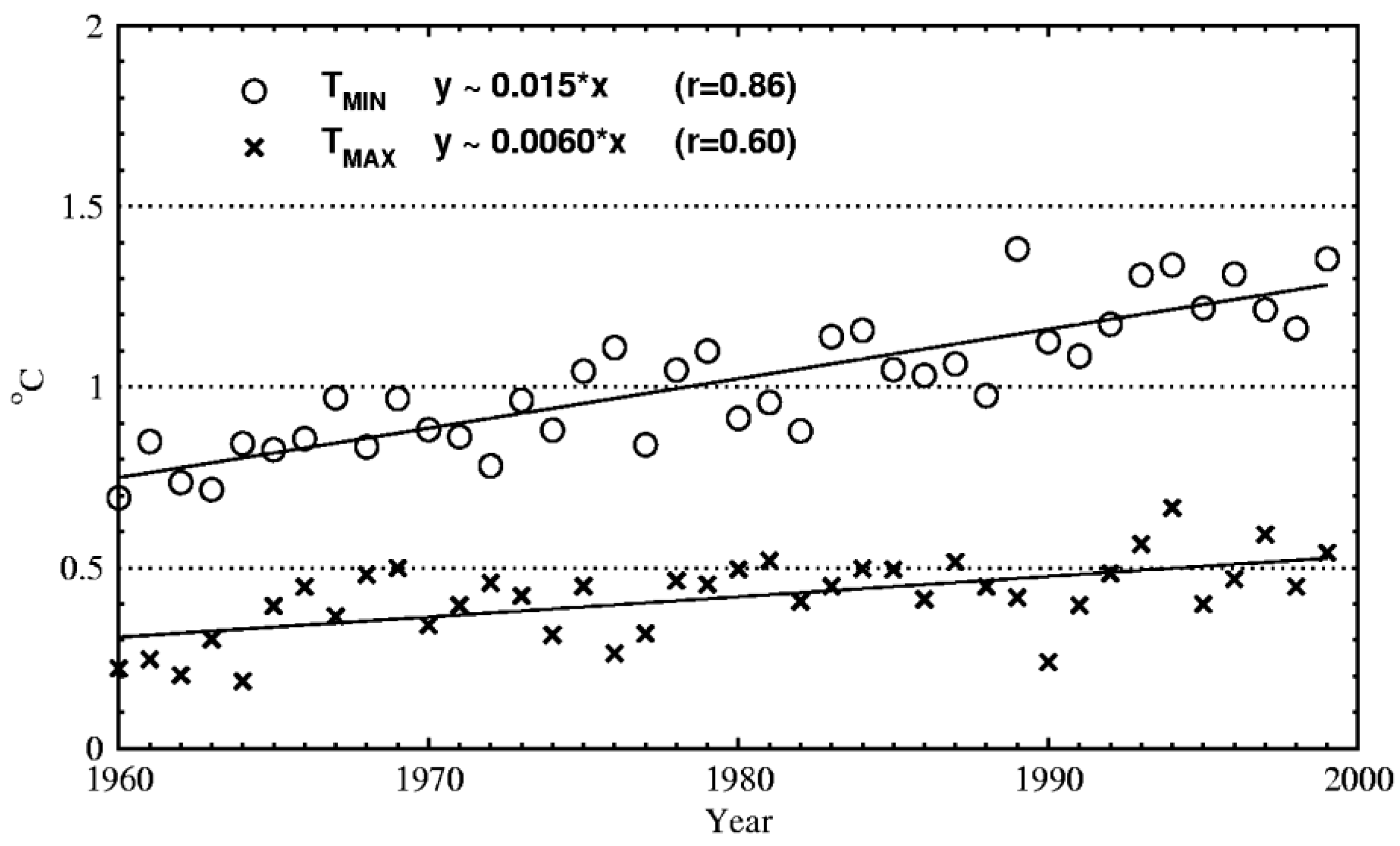
4. Conclusions
Acknowledgements
References
- Jones, P.D.; Lister, D.H.; Li, Q. Urbanization effects in large-scale temperature records, with an emphasis on China. J. Geophys. Res. 2008, 113. [Google Scholar] [CrossRef]
- Jones, P.D.; Lister, D.H. The urban heat island in central London and urban-related warming trends in Central London since 1900. Weather 2009, 64, 323–327. [Google Scholar] [CrossRef]
- Fricke, R.; Wolff, E. The MURBANDY project: Development of land use and network databases for the Brussels area (Belgium) using remote sensing and aerial photography. Int. J. Appl. Earth Obs. Geoinf. 2002, 4, 33–50. [Google Scholar] [CrossRef]
- Yuan, F.; Bauer, M.E. Comparison of impervious surface area and normalized difference vegetation index as indicators of surface urban heat island effects in Landsat imagery. Remote Sens. Environ. 2007, 106, 375–386. [Google Scholar] [CrossRef]
- Huang, L.; Li, J.; Zhao, D.; Zhu, J. A fieldwork study on the diurnal changes of urban microclimate in four types of ground cover and urban heat island of Nanjing, China. Build. Environ. 2008, 43, 7–17. [Google Scholar] [CrossRef]
- Shouraseni, S.R.; Yuan, F. Trends in extreme temperatures in relation to urbanization in twin cities metropolitan area, Minnesota. J. Appl. Meteor. Clim. 2009, 48, 669–679. [Google Scholar]
- Hamdi, R.; Deckmyn, A.; Termonia, P.; Demarée, J.A.; Baguis, P.; Vanhuysse, S.; Wolff, E. Effects of historical urbanization in the Brussels Capital Region on surface air temperature time series: a model study. J. Appl. Meteorol. Climatol. 2009, 48, 2181–2196. [Google Scholar] [CrossRef]
- Masson, V. A physically-based scheme for the urban energy budget in atmospheric models. Bound.-Layer Meteor. 2000, 94, 357–397. [Google Scholar] [CrossRef]
- Uppala, S.M.; KÅllberg, P.W.; Simmons, A.J.; Andrae, U.; Bechtold, V.C.; Fiorino, M.; Gibson, J.K.; Haseler, J.; Hernandez, A.; Kelly, G.A.; et al. The ERA-40 re-analysis. Quart. J. Roy. Meteor. Soc. 2005, 131, 2961–3012. [Google Scholar] [CrossRef]
- Peterson, T.C.; Daan, H.; Jones, P.D. Initial selection of a GCOS surface network. Bull. Amer. Meteor. Soc. 1997, 78, 2145–2152. [Google Scholar] [CrossRef]
- Fujibe, F. Detection of urban warming in recent temperature trends in Japan. Int. J. Climatol. 2009, 29, 1811–1822. [Google Scholar] [CrossRef]
- Vanhuysse, S.; Depireux, J.; Wolff, E. Etude de l’évolution de l’imperméabilisation du sol en région de Bruxelles-Capitale; IGEAT, Université Libre de Bruxelles: Brussels, Belgium, 2006; p. 60. [Google Scholar]
- ALADIN International Team. The ALADIN project: Mesoscale modelling seen as a basic tool for weather forecasting and atmospheric research. WMO Bull. 1997, 46, 317–324. [Google Scholar]
- Le Moigne, P. SURFEX Scientific Documentation; Note de centre (CNRM/GMME), Météo-France: Toulouse, France, 2009; p. 211. [Google Scholar]
- Masson, V.; Champeaux, J.L.; Chauvin, F.; Meriguet, C.; Lacaze, R. A global database of land surface parameters at 1 km resolution in meteorological and climate models. J. Climate 2003, 16, 1261–1282. [Google Scholar] [CrossRef]
- Noilhan, J.; Planton, S. A simple parameterization of land surface processes for meteorological models. Mon. Wea. Rev. 1989, 117, 536–549. [Google Scholar]
- Masson, V.; Grimmond, C.S.B.; Oke, T.R. Evaluation of the Town Energy Balance (TEB) scheme with direct measurements from dry districts in two cities. J. Appl. Meteor. 2002, 41, 1011–1026. [Google Scholar]
- Lemonsu, A.; Grimmond, C.S.B.; Masson, V. Modeling the surface energy balance of an old Mediterranean city core. J. Appl. Meteor. 2004, 43, 312–327. [Google Scholar] [CrossRef]
- Hamdi, R.; Masson, V. Inclusion of a drag approach in the Town Energy Balance (TEB) scheme: Offline 1-D evaluation in a street canyon. J. Appl. Meteor. Clim. 2008, 47, 2627–2644. [Google Scholar] [CrossRef]
- Van Weverberg, K.; De Ridder, K.; Van Rompaey, A. Modeling the contribution of the Brussels Heat Island to a long temperature time series. J. Appl. Meteor. Clim. 2008, 47, 976–990. [Google Scholar] [CrossRef]
- Landsberg, H.E. The Urban Climate; International Geophysics Series; Academic Press: New York, NY, USA, 1981; Volume 28, p. 275. [Google Scholar]
- Wilmott, C.T. Some comments on the evaluation of model performance. Bull. Amer. Meteor. Soc. 1982, 63, 1309–1313. [Google Scholar] [CrossRef]
© 2010 by the authors; licensee MDPI, Basel, Switzerland. This article is an open access article distributed under the terms and conditions of the Creative Commons Attribution license (http://creativecommons.org/licenses/by/3.0/).
Share and Cite
Hamdi, R. Estimating Urban Heat Island Effects on the Temperature Series of Uccle (Brussels, Belgium) Using Remote Sensing Data and a Land Surface Scheme. Remote Sens. 2010, 2, 2773-2784. https://doi.org/10.3390/rs2122773
Hamdi R. Estimating Urban Heat Island Effects on the Temperature Series of Uccle (Brussels, Belgium) Using Remote Sensing Data and a Land Surface Scheme. Remote Sensing. 2010; 2(12):2773-2784. https://doi.org/10.3390/rs2122773
Chicago/Turabian StyleHamdi, Rafiq. 2010. "Estimating Urban Heat Island Effects on the Temperature Series of Uccle (Brussels, Belgium) Using Remote Sensing Data and a Land Surface Scheme" Remote Sensing 2, no. 12: 2773-2784. https://doi.org/10.3390/rs2122773



